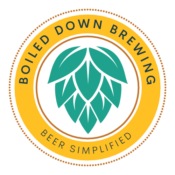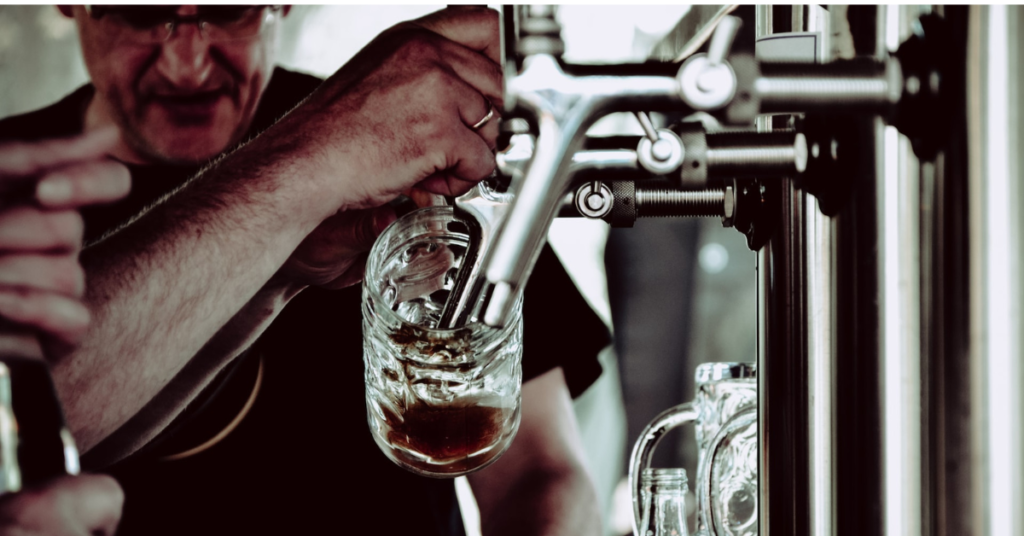Another year of the Great American Beer Festival (GABF) is in the books. There is a buzz around American-Style IPA regaining its former designation as the most-entered category, dethroning Juicy or Hazy IPA, which has been at the top of entries since being introduced in 2018. However, while the return of the American-Style IPA is notable, there is a more interesting trend in GABF entries: lagers.
Table of Contents
Boiled Down Summary
- Lager category entries at the GABF are rapidly growing with a 5-year compounded annual growth rate (CAGR) of 16.1%, while ale and ale or lager category entries are relatively flat.
- Lagers are becoming more of the most-entered categories in the competition over the last five years, with 10 of the top 25 most-entered categories being lagers in 2022.
- Dortmunder or German-Style Oktoberfest, German-Style Märzen, and International-Style Dark Lager became much more popular categories for entry in 2022 than in 2021.
Overall entries at GABF are growing
The total number of GABF entries has grown annually over the last ten years, except for 2020, and now entries hover at just under 10,000 per year. Ale entries have dominated the competition in the previous ten years, an unsurprising fact as the majority of categories for brewers to enter are ales. While the specific categories have changed from year to year, there have been roughly 90-100 categories annually. Approximately 50-60 categories have been exclusively ales, 30 categories have accepted ales or lagers (e.g., Experimental Beer, Herb and Spice Beer, etc.), and fewer than 20 categories have been exclusively lagers.

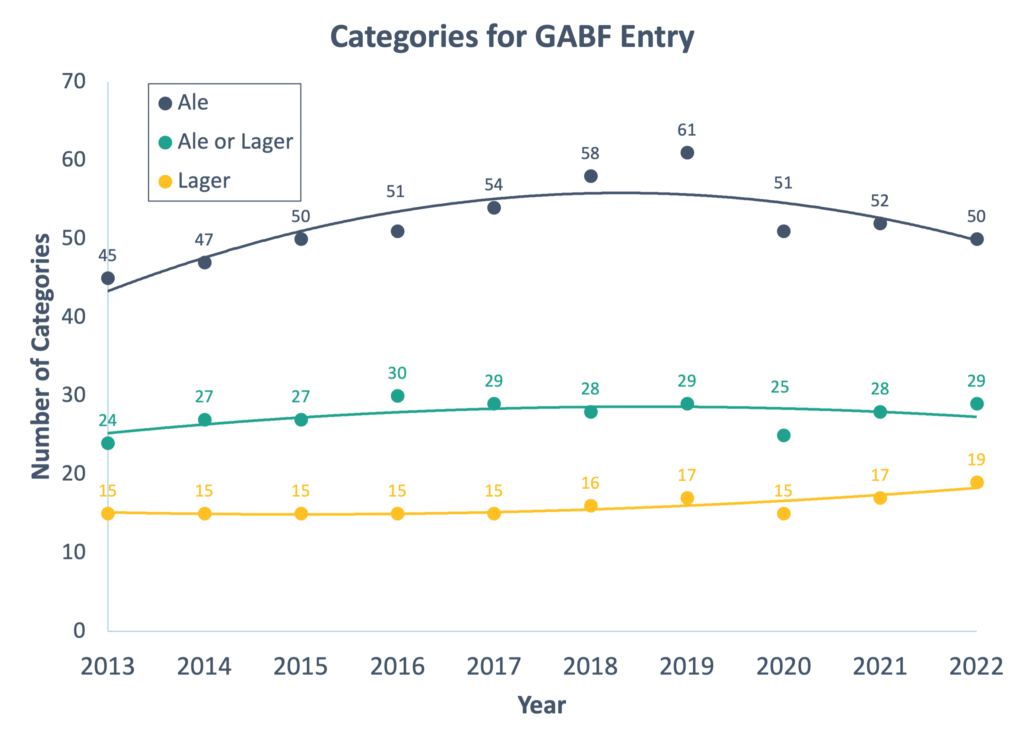
Focusing on the last five years of the competition, ale and ale or lager categories have had limited to no growth in the total number of entries, with the total number of ale entries having a CAGR of just 2.3% and ale or lager categories sitting at 0.1%. However, lager entries are a different story, with a 5-year CAGR of 16.1%, representing the most growth in entries to the GABF over the last five years.
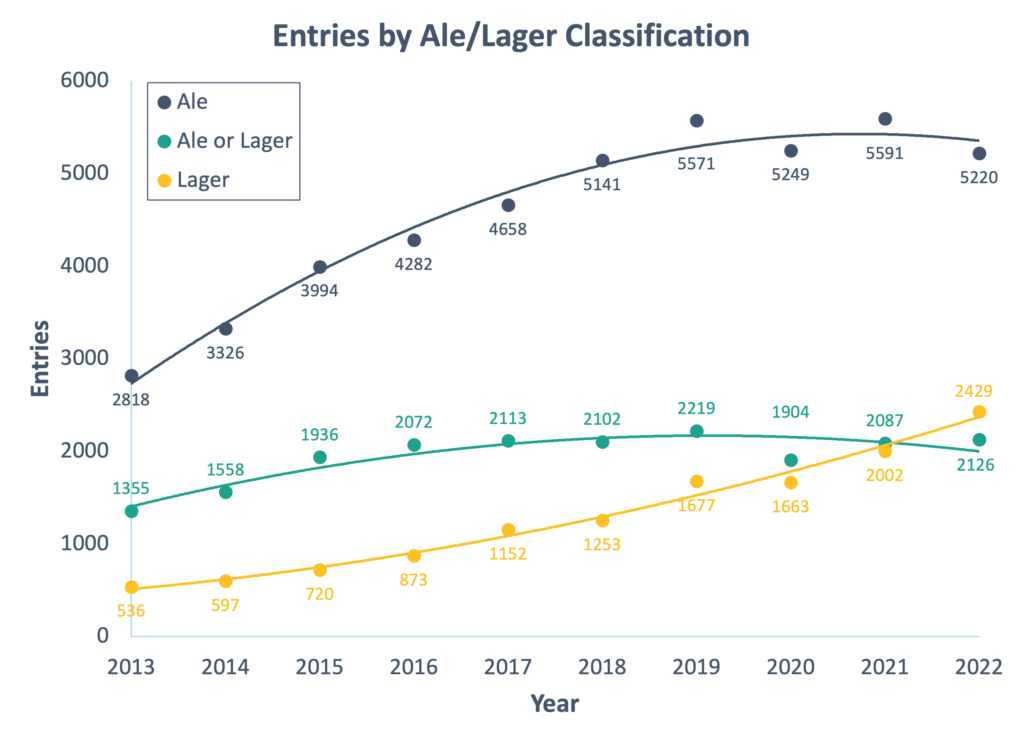
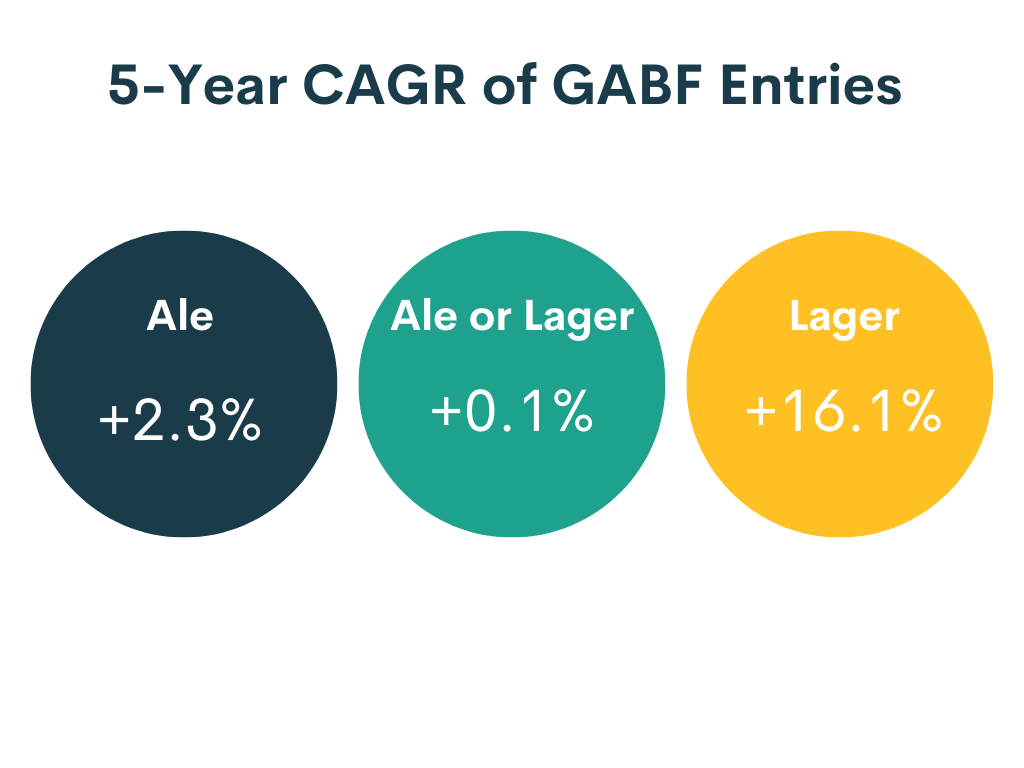
More lagers in the Top 25 most-entered categories
While there are nearly 100 categories for entry in the GABF every year, the proportion of entries in each category is skewed, with almost 50% of the total entries belonging to the top 25 most-entered categories in 2022.
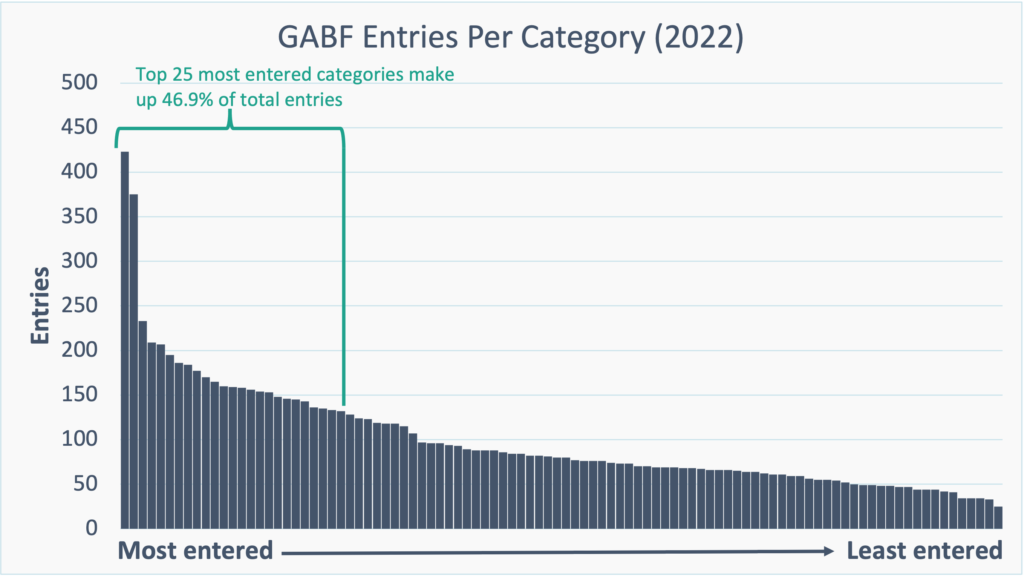
The top two categories in entries (American-Style IPA and Juicy or Hazy IPA) made up a whopping 8.2% of the total submissions in 2022. While IPA still reigns supreme, lagers are quietly rising into the top 25 most-entered categories.
Below is a table with the top 10 most-entered categories in the last five years of the GABF. For the first time in that period, four lager categories are in the top 10.
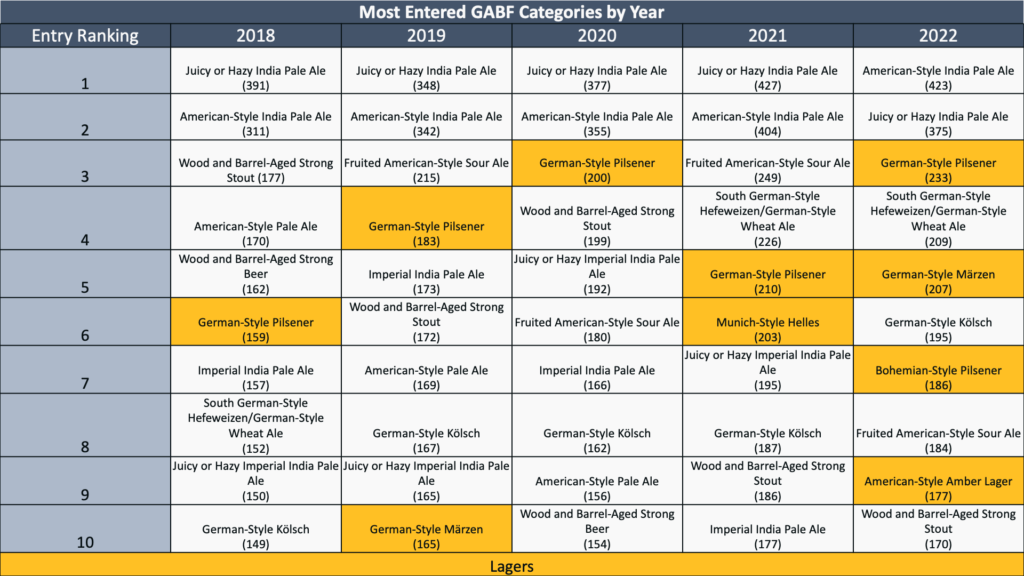
Over the last five-year period, there has been a steady increase in the number of lager categories in the top 25 most-entered categories, with 10 being lager in 2022. Of the total entries in the top 25 largest categories, 10 categories were lagers, making up 36.8% of entries, a massive increase from 7.6% in 2018. Below is a chart of the percentage of the top 25 entries by ale/lager classification and a color map of the top 25 winners by ale/lager categorization.
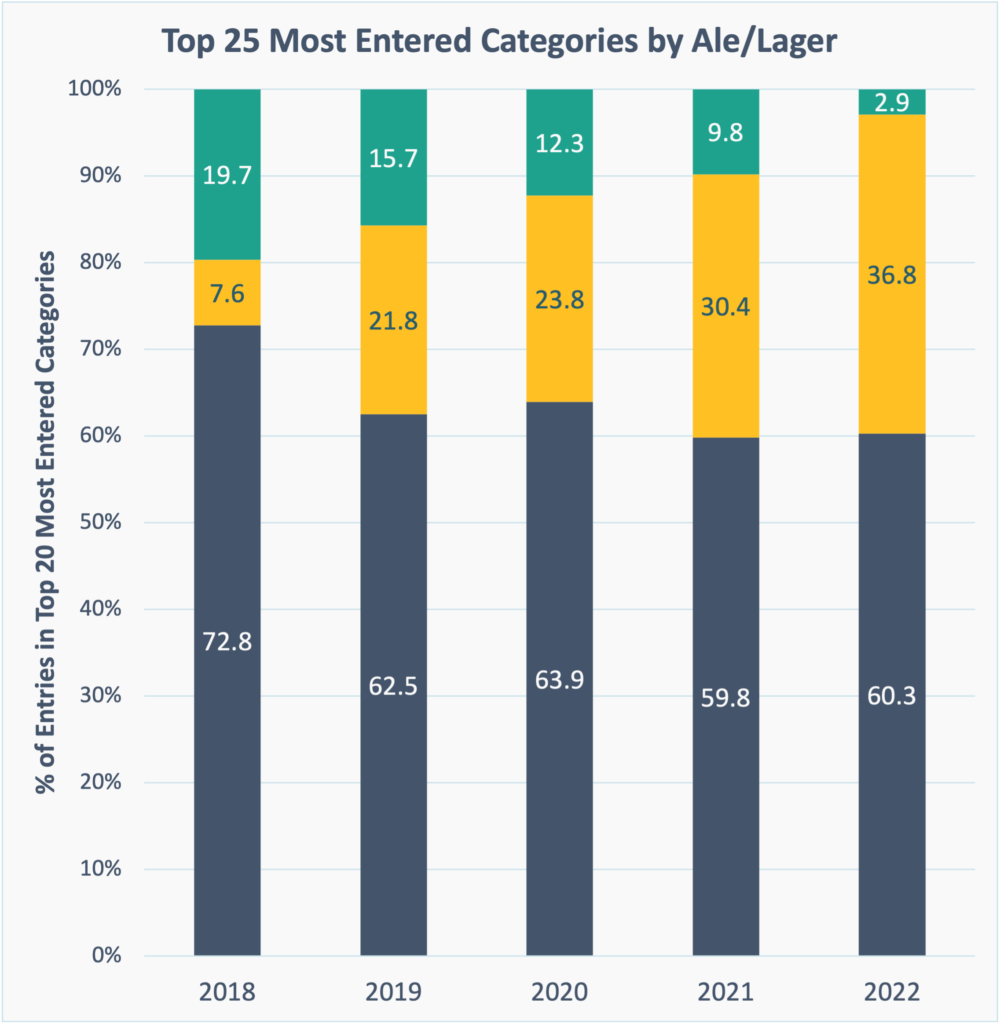

Biggest movers in category rankings are lagers
Comparing categories in the 2021 and 2022 competitions, the top three upward movers in the number of entries were all lagers. The biggest mover was Dortmunder or German-Style Oktoberfest, moving 51 places up from the 67th most-entered category in 2021 to the 16th most-entered in 2022. German-Style Märzen was the second biggest mover, going from the 48th most-entered category up to 5th. International-Style Dark Lager rounded out the top three biggest movers.
[Disclaimer: The next section of the article is solely the opinion of the author for discussion purposes only]
Why are lagers on the rise?
While the exact answer to why lagers are now on the rise may be difficult to say with certainty, I have some thoughts on why I think lagers are becoming more popular at the GABF and will continue to rise in the near future.
Craft brewers are now interested in making more lagers
The early days of the craft beer movement significantly impacted the beer styles that still define American craft beer today. Bold, assertive ales with American hops are now the hallmark of American craft beer.
Craft brewers were brewing continental lagers and other traditional styles at the beginning of US craft beer, but the newly created styles like American IPA and Barrel-Aged Stouts created an identity for American craft beer.
The American beer styles developed over the last 35 years have significantly impacted the global beer scene. This impact is evidenced by the rise of craft breweries in continental Europe, the UK, and elsewhere making American-style ales with citrusy, resinous American hops in cities that also brew classic styles. With the ale frontier already heavily explored, American craft brewers are now moving more steadily into the lager space for, I believe, several reasons:
- US craft brewers like the technical challenge of lagers. While subtle flaws like low levels of diacetyl or other off-flavors can hide in a 70 IBU IPA, they will jump out of a pale lager. Today’s craft brewers are highly skilled and experienced, with many classically educated in brewing, and making lagers allows brewers to showcase their brewing ability.
- There is a lot of room to invent and experiment with new styles. The classic lager styles will continue to be interesting, but there is also plenty of room for new ideas.
- Many major ale styles are highly crowded with competition, and lagers represent a new market segment. While fermentation and maturation time is longer, ingredient costs can be lower in lagers due to the thinner malt and (especially) hop bills compared to many of the top American ale styles.
Consumers are ready for more craft lagers
The other element to why I think lagers are primed for growth is that craft beer consumers in the US also have an increasing interest in lagers for a variety of reasons:
- US beer consumers are more beer-educated and understand classic lager styles. At the beginning of the craft beer boom in the US, it would have been difficult to market a Märzen-Style or Helles-Style lager, as many beer consumers hadn’t experienced these styles. Today, classic lager styles are much better known, to the point that Dortmunder or German-Style Oktoberfest and Märzen were both in the Top 20 most-entered categories in the GABF in 2022.
- Lagers bring variety and “sessionability” to tap lists and home fridges. While double dry-hopped IPA and barley wine can be fantastic, they are not always the right beer for every occasion. The traditional Continental European lagers are classic for a reason. They pair well with food, are highly drinkable, work well in a social, beer-garden setting, and stand the test of time. US beer drinkers know this and want freshly made examples of these styles. While the classics are still in Europe, American craft brewers can offer fresh, less time-weathered examples of these styles to consumers in the US. Golden Ale and Kölsch have long been the craft-brewed beers filling this space on tap lists, but I believe a broader palette of lagers will start to step in soon to complement these ales.
How craft lagers could grow in the US
The future is impossible to predict, but I see lagers as the next big move in craft beer in the US, and I see it happening over three phases.
Phase 1: Local mastery of classic European styles
I think this phase is well underway and is seen in the rising entries in the lager categories at the GABF. Craft brewers are embracing the classic European lager styles, and the craft lagers on the market in the US are improving. I feel there are increasingly good to excellent examples of brewed-to-style European lagers in the US, especially German Pils (or slightly Americanized versions of the style).
Phase 2: Experimental lagers – the creation of new American-style lagers
Classic lager styles will be here to stay. Still, I believe that the craft category will experiment with new types of beers in the lager category, and some examples will stick, creating new, uniquely American lager styles. I think the India Pale Lager (IPL) was an early start on this (although it didn’t stick), taking the clean lager fermentation profile and pairing it with the Americanized hop profile. Omega Yeast recently introduced a thiol-releasing lager strain that brings bright, tropical fruit thiols to the clean lager yeast profile. Combinations of new ingredients and techniques by brewers will be interesting to watch.
Phase 3: New, established American lager styles
Like ales before them, some of the new American lager styles will come out on top in popularity and become established lager styles with official style guidelines and GABF categories.
Sources of data and processing
- The number of entries for each competition category was determined from the PDF results lists released by the GABF after the competition each year and compiled manually. Historic GABF results can be found here and the 2022 results can found here.
- The categories were manually divided into ale, lager, or ale or lager categories for each year
- The 5-year CAGR was calculated for 2017-2022 after dividing the entry categories into ale, lager, and ale or lager.
